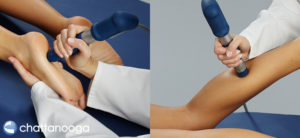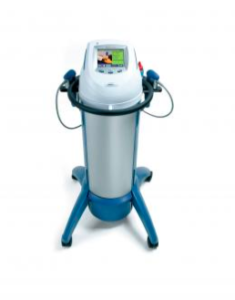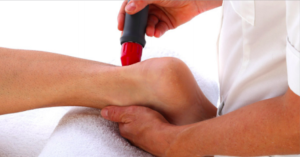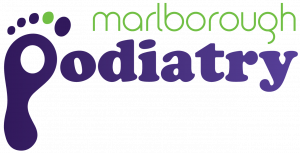Can Shockwave Help Your Pain or Injury?

Radial Pressure Wave Therapy, which is often known as Shockwave, is far from a new-to-the-market treatment. It has been tried, tested and proven for decades, originally being developed for doctors to help eliminate kidney stones over 20 years ago! It is through this exact use that the other benefits of shockwave were discovered.
Today, we’re driving into the what’s, how’s and why’s of shockwave treatment because we’re very proud to have this fantastic treatment available right here at Marlborough Podiatry!
How can shockwave help me?
Shockwave works by accelerating both tissue and bone healing in the treated area, meaning you recover and get out of pain faster than traditional therapies alone. Shockwave works to:
Reduce pain – by creating an anaesthetic effect on the nerve fibres, shockwave helps to block pain signals and help you to feel better!
Stimulate revascularisation – shockwave helps to promote the development of new blood vessels to the area, meaning more blood flow and faster healing and recovery for tissues and bones alike!
Stimulate metabolic activity – shockwave works on a cellular level to promote the release of substances that inhibit pain and inflammation, hence promoting healing and repair.
 Other benefits of shockwave include:
Other benefits of shockwave include:
– Fantastic for conditions that are normally difficult to treat
– Has shown efficacy in both new and long-standing conditions
– It’s non-invasive
– No anaesthetic or medication is required
– Very few complications or adverse effects
– Treatment can be started immediately following the consultation
– Has the potential to replace the need for surgery
– No additional pain is expected following the completion of each shockwave session
– Faster return to normal activity compared to surgical alternatives
What can Shockwave help with?
We’ve successfully treated patients with a variety of pains and injuries with shockwave, from overuse injuries following running, to accidental injuries sustained in sports and everything in between. During your consultation, after your assessment, we’ll let you know if shockwave is suitable for your problem. Examples of problems that shockwave can help with include:
– Heel pain – plantar fasciitis, Achilles tendinopathy
– Knee pain – runner’s knee (patellofemoral pain), jumper’s knee (patellar tendinopathy), kids growing pains,
– Leg pain – shin splints, posterior tibial tendon dysfunction (PTTD), peroneal tendonitis
– Growing pains – Osgood Schlatter’s disease, Sever’s disease
– Foot pain
– Trigger points
– Soft tissue adherence
 What does a shockwave session look like?
What does a shockwave session look like?
Before we can commence the treatment, you must have an assessment and diagnosis by one of our talented Podiatrists. We won’t carry out the treatment until we are confident that shockwave has the potential to help you, as we’d never want any patients wasting time and money on a treatment that can’t deliver the results they need. After we confirm your suitability for shockwave treatment and go through your complete recovery and management plan, the fun will begin!
1. We start by palpating around the target area, identifying our target spots for shockwave, and applying some ultrasound gel to these areas
2. We then adjust the settings on the machine and place the handpiece against your skin. Don’t worry! We have full control over the machine and its settings – including the intensity of the waves that will be moving through your tissues. If you are feeling particularly tender or it’s your first appointment, we can start the first round at a gentler setting so you can become familiar with what to expect from the treatment
3. Compressed air moves through the handpiece which moves a bullet-like piece within the shockwave handle at a rapid rate. This causes the shockwaves to radiate out of the handpiece, through the gel and into the targeted area
4. One round of shockwave lasts for approximately 60-120 seconds, depending on the recommended number of ‘pulses’ specific to your injury and treatment area. We completed 2-3 rounds per foot
5. After the completion of the session, we finish any complementary therapies as per your management plan, for example strapping the foot
6. You’re good to go! You continue to follow the management plan until your return in one week for your next shockwave round
7. Depending on the severity of your problem, you may require as few as 3 rounds, or as many as 9 rounds of shockwave
Don’t worry – we expect to see a reduction in your pain in symptoms every week. If we don’t see these results and you’ve completely complied with the rest of your specific management plan, we won’t continue with the treatment and will re-assess the best way forward clinically for your recovery.
How do I get started?
The first step to recovery is to book in your first appointment with our fantastic podiatry team here at Marlborough Podiatry. Not only will we assess you, confirm a diagnosis and create a tailored treatment plan that works in with your lifestyle and helps you achieve your goals, but we’ll also go over all of the treatment options and discuss which is going to deliver the best outcomes for you. You can ask us any and every question you have about shockwave – and it’s likely that we may be able to get started on your first shockwave treatment in the same appointment!
To make a booking, please give us a call on (03) 972 2927, or book online here.
